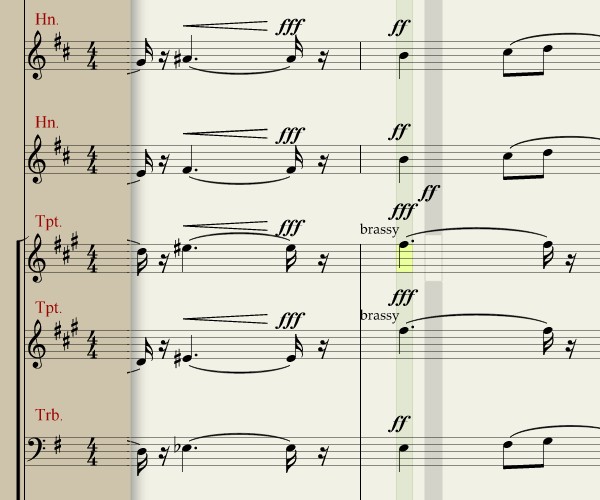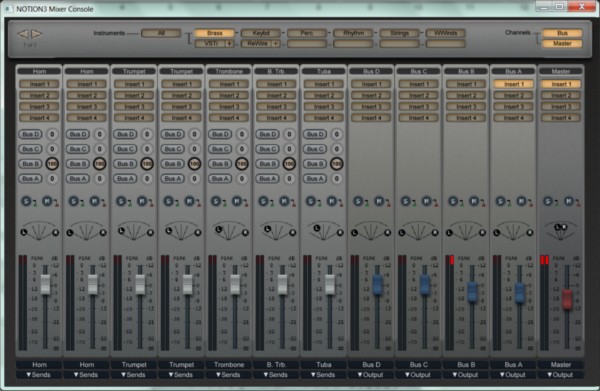A case study in improving software: What Office 2010 can learn from Notion 3

The joy of composing
I am not a professional musician, but I've always considered music a part of the artist side of my life. My most productive work in that arena was a wedding suite I composed in 1989, first for my friends and then revised for my own ceremony, using a composition program for the old Atari ST. It must actually have been somewhat good because my wife still thinks so -- and she was my editor before she was my wife.
There is a special place in my heart for symphonic music. An orchestra is, in itself, a unique and nuanced instrument, whose tonality and rhythm and timbre all exist over and above each of its individual instruments. So even though I've composed music for real and electronic instruments before -- small arrangements, jazzy ensembles, string quartets -- I never really had the personal opportunity until the advent of Notion to attempt a composition for anything that truly sounded, or even approximated, a full orchestra.
The beauty of Notion 3, therefore, is the ability to pick up an orchestra the way one picks up a guitar or a saxophone, or sits down to a piano. It's a way of handing an orchestra to someone and saying, "Hey, try this!" with the same carefree and eager gesture as my mother -- an art teacher who loved music -- would have handed someone an autoharp or an harmonica. Since so much of the music that has lived in my head for years has started out symphonic, Notion gives me the freedom to avoid boiling the melody and the rhythm down to something that will fit on four or six instruments, or however many the band or sound card can faithfully reproduce.
And yes, Notion contains parts for instruments you wouldn't normally find in a symphony orchestra, like a screaming electric guitar (screaming courtesy of AmpliTube XGear, which once you figure it out, is a scream in itself). But there have been any number of movies recently whose entire presentation to the audience, I feel, could have been enhanced with a complete rethink of the orchestration, courtesy of Carlos Santana.

A new type of cursor: Here in the composition screen, I'm about to replace a fortississimo (fff) with a fortissimo (ff). Everything in a symphonic score is synchronized vertically, so the shaded bars represent points in time. The olive-shaded bar is the area I'm about to change, and the yellow brick points to the specific instrument (Trumpet 1). The grey bar is my mouse pointer now, and the "ff" is the symbol that replaces my pointer arrow. When I click on the score, I move the olive bar to that point; if I click Play, that's the part I hear. And if I press the A key, I hear the note under the yellow brick. The grey bar shows me where I can move the olive bar, and where I'm about to insert my new ff dynamic.
The sound snippet I've included here for download is about 30 seconds of a demo reel I produced using a score using pieces of a composition from Notion 2, that I spruced up using Notion 3. The first theme you hear is something I believe I started humming to myself one day while watching a piece of the PBS documentary "Carrier" with the sound turned down, on account of my wife talking on the phone. Months later, the theme crept up in my mind again as something I wished could have been used in a particular movie, the identity of which I'll keep secret for now, but which folks who know me well will be able to guess right away -- I was disappointed by the score, and used Notion to challenge myself to see whether I could replace it.
Since my work started in Notion 2, I was able to learn something valuable about not only musical scores, but any type of electronic document that has been tailored to suit the quirks and nuances of its native application. Because Notion 2 was also a sound system, managing the nuances of that sound system required "massaging" the score, if you will, to balance the instruments. That included over-weighting the dynamics of entire instrument sections just to make Notion 2 sound better than just "good," though if you were to print the resulting score, it would confuse a real-world conductor.
Notion 3's score format has also changed, so bringing over a Notion 2 project requires a file import. That import leaves the over-weighted balances exactly where they were -- so with respect to the printed output, it's a mostly accurate import (the new format was confused by the old fermatas, but such small adjustments are easy to fix). But the result sounded...perfectly horrible, as though the horn section were collectively suffering an asthma attack, and buzzsaws were tearing through the violas.
"That was one of the inherent problems in Notion 2," Lubo Astinov admitted, "the balance of the sounds was completely ridiculous. It hurt many scores and many users, because they were basically -- and we were doing it here -- over-exaggerating dynamics to get the desired sound, which should have never happened. You don't do that for a real orchestra; you shouldn't have to do that for a Notion score as well."
The first part of the solution involved going back through the project and toning down the dynamics to something more realistic, which in some cases literally meant bringing fortissississimo (ffff) back down to as low as forte (f). The entire piano range (soft) was suddenly opened up, because now it was actually audible.

The second part involved utilizing the new sound mixer panel, which replaces Notion 2's "mute/unmute" dialog with a completely graphical representation of a real studio channel mixer. Add-on effects such as AmpliTube, and VST effects plug-ins from the outside world, "attach" to this panel as though they were filter components. You can then route the sound from one instrument through one of these plug-ins, or group several instruments (for instance, the whole horn section) into a bus that leads through a filter.
This very tactile approach to sound mixing runs almost completely opposite of the wholly symbolic approach to composition presented by the Notion 3 palette, almost as though you're using a different program altogether. Nevertheless, the mixer provides very granular, explicit functionality, replacing Notion 2's generalized functionality, and matching N3's level of detail in scoring. If I were applying a more holistic approach to the application's design, I might have imagined an other-worldly "mixer palette" that works similar to the scoring palette. But a studio musician might have found such a device foreign.
To this day, Notion is not a "perfect" program, if there is such a thing. Lubo Astinov audibly winced when I told him I was using standard Realtek integrated audio on my test system; relying on ordinary components such as this has been the cause of many troubles. The most pressing problem I've encountered thus far has been the sound system tripping over the score and losing synchronization of measures, a problem we've traced back to AmpliTube set to "oversampling" by default -- a setting that's not obvious to a novice. Every so often, N3 still trips over the score even with this setting turned off, especially if it has to share memory with other applications (for example, this word processor I'm using now, or anything that relies heavily on the .NET Framework).
But the program itself amazes me so much that not even these problems have become headaches -- it still feels miraculous, at least to me, that Notion 3 is capable of doing as much as it does. If I were a professional musician, making a living from my score, I might need an aspirin or two. (I might also invest in a real sound card.) For now, I manage to find enough inspiration from the quality of what's possible that the act of using this program continues to be a joy.
One wonders how many people throughout the history of written music would have been able to bring themselves to an artistic par with Ludwig van Beethoven, or Jean Sibelius (the real one), or Dmitri Shostakovich, or Jerry Goldsmith, had they the same access to an orchestra that minds their commands the way Beethoven's orchestra-in-his-head minded him. How many untried artists with un-nurtured talents were left waiting, and how many such artists may become inspired today with such power at their control now?
Imagine what brilliance is possible when we hand the world an orchestra.
